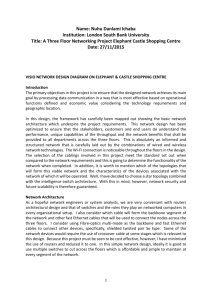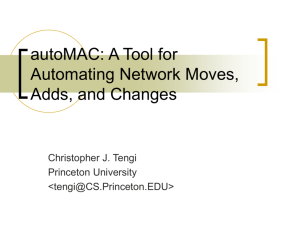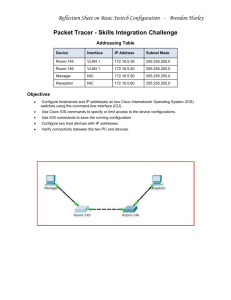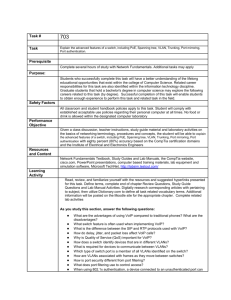4-ccna bryphil vlan
advertisement
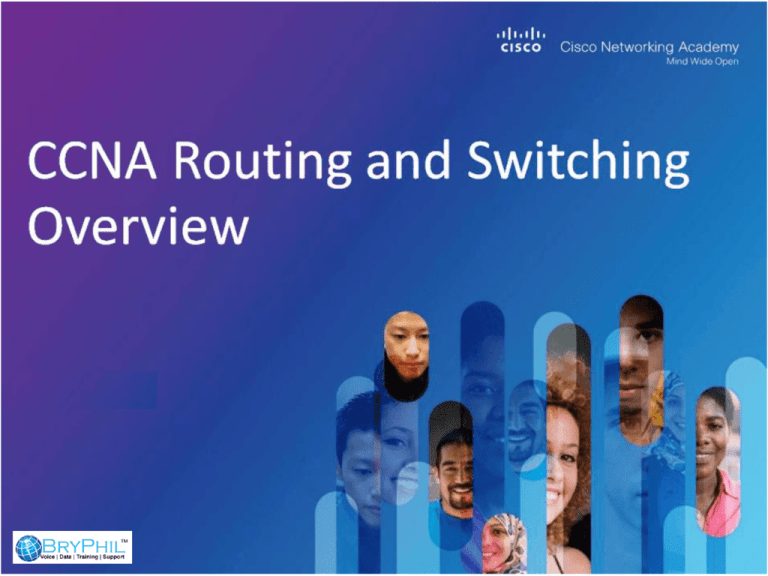
V irtual L A N ocal rea VLAN etwork VLAN Network performance is a key factor in the productivity of an organization. One of the technologies used to improve network performance is the separation of large broadcast domains into smaller ones. VLANs provide a way to group devices within a LAN. A group of devices within a VLAN communicate as if they were attached to the same wire. VLANs are based on logical connections, instead of physical connections. VLANs allow an administrator to segment networks based on factors such as function, project team, or application, without regard for the physical location of the user or device. Devices within a VLAN act as if they are in their own independent network, even if they share a common infrastructure with other VLANs. Any switch port can belong to a VLAN, VLANs improve network performance by separating large broadcast domains into smaller ones. If a device in one VLAN sends a broadcast Ethernet frame, all devices in the VLAN receive the frame, but devices in other VLANs do not. Each switch port can be assigned to only one VLAN Each VLAN in a switched network corresponds to an IP network Types of VLAN Data VLAN A data VLAN is a VLAN that is configured to carry user-generated traffic. Default VLAN All switch ports become a part of the default VLAN after the initial boot up of a switch loading the default configuration. Switch ports that participate in the default VLAN are part of the same broadcast domain. This allows any device connected to any switch port to communicate with other devices on other switch ports. The default VLAN for Cisco switches is VLAN 1. VLAN 1 has all the features of any VLAN, except it cannot be renamed or deleted. By default, all Layer 2 control traffic is associated with VLAN 1. Native VLAN A native VLAN is assigned to an 802.1Q trunk port. An 802.1Q trunk port supports traffic coming from many VLANs (tagged traffic), as well as traffic that does not come from a VLAN (untagged traffic). The 802.1Q trunk port places untagged traffic on the native VLAN, which by default is VLAN 1. Management VLAN A management VLAN is any VLAN configured to access the management capabilities of a switch. VLAN 1 is the management VLAN by default. To create the management VLAN, the switch virtual interface (SVI) of that VLAN is assigned an IP address and subnet mask. LAB 1. 2. 3. 4. 5. 6. 7. 8. Identify the different default VLAN configurations on a switch. Create VLANs and name them. Identify different switch port modes(Trunk and Access mode). Identify transmission mode(Auto, Full duplex, full and half duplex) How to assign a port to a specific VLAN How to assign a range of ports to a VLAN How to delete a VLAN Look at VLAN commands A VLAN trunk, or trunk, is a point-to-point link between two network devices that carries more than one VLAN. A VLAN trunk extends VLANs across an entire network A VLAN trunk does not belong to a specific VLAN; rather, it is a conduit for multiple VLANs between switches and routers Configuration Key Words 1. 2. 3. 4. 5. 6. 7. 8. 9. VLAN Switchport Mode Access Mode Trunk Trunk port Encapsulation Dot1Q No version of all commands Logical separation Caution: Before deleting a VLAN, be sure to first reassign all member ports to a different VLAN. Any ports that are not moved to an active VLAN are unable to communicate with other hosts after the VLAN is deleted and until they are assigned to an active VLAN. Alternatively, the entire vlan.dat file can be deleted using the delete flash:vlan.dat privileged EXEC mode command. VLAN Review On corporate network, hosts on the same VLAN can communicate with each other, but they are unable to communicate with hosts on different VLANs. What is needed to allow communication between the VLANs? A. a router with subinterfaces configured on the physical interface that is connected to the switch B. a router with an IP address on the physical interface connected to the switch C. a switch with an access link that is configured between the switches D. a switch with a trunk link that is configured between the switches Cisco Catalyst switches CAT1 and CAT2 have a connection between them using ports Fa0/13. An 802.1Q trunk is configured between the two switches. On CAT1, VLAN 10 is chosen as native, but on CAT2 the native VLAN is not specified. What will happen in this scenario? A. 802.1Q giants frames could saturate the link. B. VLAN 10 on CAT1 and VLAN 1 on CAT2 will send untagged frames. C. A native VLAN mismatch error message will appear. D. VLAN 10 on CAT1 and VLAN 1 on CAT2 will send tagged frames. Which of the following are benefits of VLANs? (Choose three) A. They increase the size of collision domains. B. They allow logical grouping of users by function. C. They can enhance network security. D. They increase the size of broadcast domains while decreasing the number of collision domains. E. They increase the number of broadcast domains while decreasing the size of the broadcast domains. F. They simplify switch administration. A frame from VLAN1 of switch S1 is sent to switch S2 where the frame received on VLAN2. What causes this behavior? A. trunk mode mismatches B. vlans that do not correspond to a unique IP subnet C. native vlan mismatches D. allowing only vlan 2 on the destination. Which statement about vlan operation on Cisco Catalyst switches is true? A. when a packet is received from an 802.1Q trunk, the vlan id can be determined from the source MAC address table. B. unknown unicast frames are retransmitted only to the ports that belong to the same vlan. C. ports between switches should be configured in access mode so that vlans can span across the ports. D. broadcast and multicast frames are retransmitted to ports that are configured on different vlan. Which two benefits are provided by creating VLANs? (Choose two) A. added security B. dedicated bandwidth C. provides segmentation D. allows switches to route traffic between subinterfaces E. contains collisions Assuming the default switch configuration which vlan range can be added modified and removed on a Cisco switch? A. 2 through 1001 B. 1 through 1001 C. 1 through 1002 D. 2 through 1005


